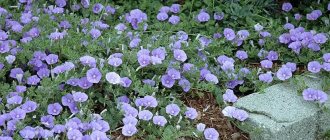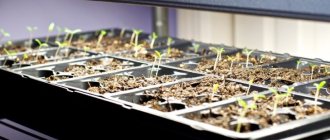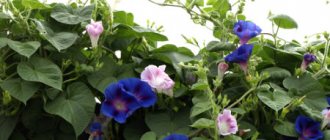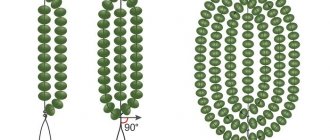The most beautiful blooming indoor flowers photos and names
In nature, there are many domestic crops grown on windowsills. This section presents flowers with bright inflorescences that do not stop blooming almost all year round.
Begonia
Not a capricious houseplant that blooms all year round. Begonia blooms with lush inflorescences all year round with proper care. The flower loves light and is undemanding to soil and temperature conditions. In the summer it is taken out onto the loggia without harm to health. Transplanted by cuttings. To make the crop lush, it is pruned.
Abutilone
Thanks to its leaves, the home flower received the name “indoor maple” among gardeners. The plant is not whimsical; it requires constant, careful watering and good daylight. The best soil for flowers is deciduous humus with sand, turf, and mature manure. For abundant flowering, abuliton is fed with superphosphates and saltpeter. Will require pruning in spring. Propagated by cuttings.
Hibiscus
A picky indoor shrub that grows in houses up to 2 m. It blooms from spring to autumn with large flowers of whitish, bright red, and pink colors. The plant is sun-loving. In summer it requires good watering. In winter, the culture is kept at a temperature of 16-17C. Propagated by cuttings. Suitable soil: humus/peat, turf, a little sand. In spring, the flower is pruned to form a bush shape.
Anthurium
The plant is divided into decorative deciduous crops and flowering ones. Blooms in light red, crimson, red. Loves light and thermometer division not lower than 18C, moderate watering. Flowers do not mind irrigation. They are planted by cuttings and cutting off the side stems. The substrate must be drained.
Clivia
The indoor flower is characterized by dark green leaves. During flowering, a long stalk with yellow-orange buds is formed on it. The plant tolerates shade. With fertilizing, clivia will bloom even in a dark room. The crop is propagated by root “babies”, separating them from their parents and planting them in a substrate of sand, turf, or leaf soil.
Indoor roses
An ornamental plant that prefers plenty of light does not tolerate overheating. House flowers come in a variety of colors. After acquisition, the crop is immediately transplanted into nutrient soil. In favorable conditions, the rose blooms all year round with a short break.
The flower takes watering well; it is important not to let the soil dry out. Feed indoor roses every two weeks. Prune the plant by removing faded buds, dry leaves and branches.
Pelargonium
Blooms with bright exotic balls (dormant period November-February). The plant's homeland is South America. In total there are from 280 to 350 species. The essential oil of the flower kills harmful bacteria and helps purify the air in the house. The culture is not fussy to care for and loves light. Water pelargonium sparingly without over-watering. To prevent the flower from stretching, it is trimmed into a neat bush. Propagated by seeds and cuttings.
Kalanchoe
The most amazing indoor flower. Considered a succulent. Homeland is Madagascar, Australia, southern Africa. All varieties of Kalanchoe are grown in pots. The plant is sun-loving. Temperatures for growing Kalanchoe in summer are 20-25C, in winter - 15-18C. Water the plant rarely, but abundantly. Feed with fertilizers for cacti. After flowering, prune. Reproduction occurs by seeds, cuttings, “babies”.
Saintpaulia
Another name for the flower is Uzambara violet. Refers to perennial herbaceous plants. Small exotic indoor flowers tolerate shade and are unpretentious. Blooms almost all year round. East Africa is considered the birthplace of the plant. Today, the originators have developed many varieties and types of flowers that differ in external characteristics. The best conditions for growing crops: temperature 16-24C, humidity 60-70%, no draft. Water the “queen of flowers” moderately (you can put it in the tray of a flowerpot). Spraying is contraindicated. Propagated by small bushes.
Vallota
A perennial bulbous plant with dark green leaves that grow up to 40 cm in length and up to 4 cm in width. The bases of the plates always have a rich purple color. Blooms in May-June and September-October. On a leafless peduncle, from 2 to 9 bright scarlet buds, similar to funnels or bells, can open.
To admire the graceful flowering of the wallflower twice a year, you need to create comfortable conditions for it:
- Find a place on a well-lit windowsill. Direct exposure to sunlight is allowed. But on hot days the plant needs to be shaded.
- Suitable ambient temperature 25°C from April to October, 10°C in winter.
- During the growing season and flowering, it is necessary to feed with universal fertilizer once every 14 days.
- Watering is moderate, regular spraying is desirable. In this case, water should not get on the inflorescences. In winter, soil moistening is carried out after sufficient drying (but not drying out) of the soil clod.
Vallotta needs to be “housed” in a small, slightly cramped pot. Wide and deep flowerpots will allow the mother bulb to gain strength, which will lead to massive growth of the children. But you will have to forget about flowering.
Important! Valotta is poisonous. She should not be allowed to come into contact with small children or animals. Work with the plant should be carried out with gloves. The maximum amount of poison is concentrated in the bulb.
Non-flowering indoor plants photos and names
Having looked at catalogs with photographs and names of indoor flowers, you will notice that all non-flowering plants look beautiful. They do not need to waste energy on flowering, forming buds and inflorescences. All their strength goes into decorativeness, filling the trunk, leaves, crown with strength.
Crassula
The houseplant has a dense, woody trunk and fleshy green leaves. It is grown in the shade and in the sun, although it does not tolerate direct sun rays. Easy to care for. Does not require abundant watering or spraying. To make the leaves shine, they are wiped from dust. Another name for Crassula is “money tree”. According to Feng Shui, a home flower brings wealth and prosperity to the home.
Dracaena
The culture belongs to the Dracaena family. The flower is divided into two groups: tree-like and bush-like. Plants do not require abundant watering or spraying. The exception is the heating season. Dracaena leaves are narrow, saber-shaped, wide and long. In appearance, the indoor flower resembles a palm tree, but in fact, it has nothing to do with them.
Aglaonema
House flowers of the araceae family. There are several varieties in nature. Some of the species produce flowers and fruits. Many gardeners value the plant for its bright and unusual leaves with silver veins inside. Therefore, for those who are interested in catalogs with photos and names of indoor plants and flowers, aglaonema is perfect. The culture grows slowly and does not require abundant sunlight. Does not require spraying, except during periods of increased dryness, that is, in winter.
Ficus
Not a thriving culture. The plant is not too demanding to care for. It tolerates shady window sills. It is recommended to increase watering in the summer, and during the rest period, in winter it is reduced. Feed the indoor flower with fertilizers for fixings and standard mineral complexes. This is done from Vienna until mid-autumn.
Fact! Buddhists consider the plant to be a sacred plant. Also, those who dream of becoming a parent should buy ficus flowers. They say that culture contributes to the birth of a child.
Monstera
Depending on the care and life expectancy, the flower can be in the form of a spreading bush or a small tree. Large umbrella leaves perfectly fill the air with ozone and decorate the room.
The plant does not like direct sunlight and grows well in the shade. Sometimes it is sprayed. The monstera is also wiped with a damp cloth to remove dust. The culture copes well with low temperatures. It is optimal to place the flower in a room with a temperature of 10-14C in winter.
Weddel coconut
The shape of the indoor flower is a smaller copy of a real palm tree bearing coconuts. The culture grows slowly at home up to 1.5 m. The pot needs to be free for the comfort of the roots. The plant prefers light and warmth. It is recommended to avoid direct sunlight.
Alocasia
An expressive indoor plant that has become especially widespread in recent years. Some varieties have medicinal properties, but it is extremely prohibited to treat yourself, because the culture is toxic. People called it “elephant ears” because of its size and shape of the foliage. Tropical evergreen crop with large leaves (grow up to 70 cm). Depending on the species, the home flower has different leaf colors: copper-green, flowery with whitish spots, wavy edge with a silver edge.
Aloe
Another name for the flower is “agagave.” The plant belongs to the medicinal succulent flowers that love sunlight. Recently, the fashion for this beautiful culture has returned. It does not need to be watered often, otherwise the roots will rot. It is best to place the plant on window sills or a glassed-in loggia. In winter, aloe is provided with artificial lighting, since it can lose its decorative effect by stretching uphill.
Air
Perennial of the Airaceae family. Cereal and herbaceous varieties are available for sale. The plant is native to Japan and East Asia, where it grows in shallow water and swampy areas.
The flower is characterized by narrow leaves collected in a bunch. The length of the leaves is 45 cm. The color and length of the leaves differ depending on the litter.
Tips for caring for plants
Accustomed to special living conditions, tropical plants require special care.
Light
Place the plants on the windowsill - they need good lighting. However, make sure that they are not exposed to direct sunlight. White paper glued to the window or blinds can help here.
Temperature
Comfortable temperature ranges from +15 to +25 °C. Make sure that the temperature in the room is maintained during the winter season.
Air humidity
It is difficult for plants accustomed to conditions of high humidity to tolerate the dry air of ordinary apartments. You can correct the situation with a humidifier and a bowl of warm water and a fan.
Capacity
One of the most important nuances of competent floriculture is the correct selection of containers. You need to focus on the size of the root system, but you shouldn’t suddenly transplant the flower into a large container - the maximum difference should be no more than 5 cm.
The soil
For comfortable growth, life and flowering, it is necessary to prepare loose soil with a high organic content.
Watering
Tropical plants should not be flooded with water; they should be watered when the soil in the pot has already dried out. But irrigation will have to be done regularly - every two to three days.
Fertilizer
In order not to harm the overseas flower, approach the issue of fertilizing with great responsibility - dose the fertilizer. The grams indicated on the package should be reduced by 1.5 times. It is better to feed more often, but in minimal doses.
Poisonous indoor flowers and plants photos and names
This section of the catalog of indoor flowers and plants contains some household crops that are distinguished by their beauty combined with toxicity. To learn more about the representatives of the flora, their photographs and names, read our entire article.
Cyclamen
People are sure that cyclamen drives away fears and bad dreams. It is often placed at the head of the bed. It is worth immediately noting that the flower is poisonous. Sometimes you come across information that the juice of the plant’s root is dripped into the nose to treat sinusitis - this is a terrible mistake. The temperature may rise, the mucous membranes may burn, the throat may become sore, and breathing may become difficult. Toxic parts of the flower: root system, seeds, juice, causing decay, irritation of the dermis.
Amaryllis beauty
The houseplant has toxic bulbs. They contain galantisine alkaloid. In a small dosage, lycorin provokes expectoration, in a large dose it provokes vomiting. If a plant leaf bursts and releases juice, you need to treat your hands and do not rub your eyes.
Dieffenbachia
An indoor flower can improve the air in a room. However, it cannot be placed in bedrooms. The plant sap is toxic, especially the stem sap. It provokes breathing problems, the digestion process, and provokes burns on the dermis. If there are flowers in the house, it is best to take care of it with gloves.
Geranium
The plant is naturally beneficial. On the one hand, geranium acts as a disinfectant, relieves tension, pain from sore throat, and otitis media. But there are people who suffer from allergic reactions after smelling the smell of geranium. Also, homemade flower is extremely dangerous for pregnant women, young children, people suffering from low blood sugar and taking contraceptives.
cacti
The plants are not toxic, but only dangerous with their thorns. For example, the trichocereus cactus contains psychotropics, can cause paralysis of the central nervous system, its effect is similar to that of a semi-synthetic psychoactive substance from the lysergamide family.
Rhododendron
Another name for the indoor flower is “azalea”. The plant is picturesque, has lush whitish, pink, red inflorescences. Only leaves that contain a toxic substance, a glycoside, that causes poisoning, are toxic in indoor flowers. Azalea should not be kept in the bedroom. Place flowerpots with plants in places protected from “little brothers” and children.
Ivy
A shrub similar to a liana. Belongs to the Araliaceae family. The leaves are dark green with a carved border, the stems are long and curved. The flower has toxic berries and leaves if ingested by the human body. Cats are particularly affected by ivy. They are attracted by the luscious greenery of the crop.
Croton
Belongs to the Euphorbiaceae family. One of the famous, widespread flowers among gardeners due to its large leaves of unusual colors. The plant is toxic because of its seeds and juice. A toxic liquid appears when the leaves and stem are damaged.
Spurge
Widespread indoor flower. Euphorbia looks like a small palm tree: dense green leaves are placed in a bunch at the top of a thick stem. The seeds and juice of the crop are poisonous. During transplantation, all precautions should be taken.
Brunfeelsia
The plant grows in Europe and the USA. Belongs to the nightshade family. It smells great and blooms with bright lilac inflorescences.
All parts of the crop are poisonous. Particularly a lot of poison is contained in the seeds and fruits.
Episcia
The indoor flower attracts attention not only with small, single red flowers, but also with decorative leaves from green to purple. Their main feature: a velvety surface with intricate patterns and the ability to reflect light. Due to this, it seems that the plant is flickering.
Epistomy care includes:
- Placement near windows facing east or west. This will provide the necessary amount of light, but without direct sunlight.
- Maintaining air temperature 20°C-25°C regardless of the time of year.
- Regular watering twice a week. In winter, less often, only after the top layer of soil has dried.
- Feeding during the flowering period. The concentration of fertilizers should be no more than 1 g of the drug per 1 liter of water.
Having chosen a place for the plant, it is advisable to avoid moving or turning it in the future. Otherwise, the leaves will not line up in a mosaic, and it will become impossible to see the incredibly beautiful “luminous carpet”.
Interesting! Episcia increases vitality, improves mood, and facilitates communication within the family. The flower radiates the energy of goodness and joy, so it can be placed in any room. But experts advise removing the plant from the children's room at night.
Bulbous indoor plants photos and names
The catalog presents indoor flowers with shoots in the form of bulbs. It is in them that plants accumulate useful substances. Many crops completely shed their leaves during the rest period. Most of the domestic flora representatives have beautiful and large flowers. Only a few are valued for their unusual leaf shape.
Hemanthus
The culture grows in Africa. It grows in height up to 30-40 cm. It is distinguished by shaggy inflorescences. It blooms in red and beige, usually in spring and summer. From one bulb grows 2-6 leaves, fleshy or transversely leathery. At home, only hybrid species are found.
Weltheimia
The flower grows up to 60 cm with large roots, bare plump stems, and mundane leaves. A peduncle with thick clusters of red, pink, yellow tones blooms in a cool room from January to March. The inflorescence is unique and showy. Depending on the conditions of detention, it can live from 1 to 5 years.
Freesia
All varieties of indoor plants are fragrant. Freesia grows 30-45 cm in length. The pedicels are soft orange, yellow, bright red, crimson, and whitish.
Hymenocallis
The home plant is distinguished by its unusual, original white buds, presented in the form of an umbrella, on which dozens of flowers are formed. The culture smells good. The plant is considered an unpretentious indoor flower. It is grown in different conditions (it will refuse to bloom in a dark room). In Greek, the name of the flower Hymenocallis means “beautiful film.” After looking at the photographs from the catalog, you will understand why it was called that.
Gloriosa
This is a crop with thin stems that requires staking to a support. A dwarf houseplant rarely grows above 30 cm. The leaves are ovate. The legs are long. At their top, pedicels of soft yellow, red-green, purple, and crimson shades appear.
Eucomis
People call the flower “pineapple” because... its inflorescences look like an extraordinary fruit. The plant grows up to 70 cm in height, blooms only after 6-8 leaves appear. Peduncles look like small bells of a white-yellow or bur-green hue. In order for the crop to bloom vigorously, it is recommended to place it on the south side, darkening it from the direct rays of the sun.
Daffodils
Grows up to 20 cm. Has linear leaves, stems without leaves. On one pedicel, 2-10 flowers of different sizes and colors can form.
The flower is characterized by a delicate aroma. Grows both in a pot and in open ground.
Names, descriptions and photos of indoor plants with red leaves
The most common houseplants with scarlet leaves are poinsettia, cordyline, irezine, coleus, aglaonema and royal begonia. Descriptions and photos will allow you to choose the most suitable plants for any home interior.
Poinsettia or "Christmas Star"
Poinsettia is a bright representative of the Euphorbiaceae genus, which attracts attention with its scarlet leaves. The plant acquired its second name “Christmas Star” due to the fact that it blooms in the winter (December-January). The flower is native to Central America and Mexico. In addition to its beautiful appearance, the plant has medicinal properties.
Poinsettia has an inconspicuous white small inflorescence, under which there are large scarlet leaves that add beauty to the appearance of the flower.
The flower is negatively affected by temperature changes, so it is necessary to avoid drafts and places near the radiator. The most comfortable temperature is +18 degrees. Another necessary condition is spraying and wiping the leaves with warm water. Water the flower as soon as the substrate is completely dry.
Cordilina
Cordyline is a beautiful representative of the tropics, which is called the false palm. Long, large leaves form a thick and lush crown of the flower. After some time, the lower tiers fall off, the stem becomes bare, and the upper part remains. The plant also has small flowers that are collected in a spike-shaped inflorescence and have a red tint. The upper part of the cordyline is painted in a rich burgundy color, which is why it attracts attention.
Cordilina
In order for the plant to grow actively, it is necessary to provide it with diffused lighting, since direct sunlight can cause burns. Watering is carried out when the top layer of the substrate is completely dry. Cordyline needs to be replanted every spring. Florists also recommend choosing slightly acidic soil for better growth.
Coleus
The main feature of coleus, a flower native to tropical hot countries, is its burgundy leaves, which are framed at the edges with a green stripe. Coleus belongs to the Lamiaceae family and is distinguished by its ease of care. People call the flower the poor man's croton, since its color is very similar to him.
The leaves of the flower have a heart-shaped elongated shape with wavy, serrated edges. They may differ in size and shape in different varieties. Coleus also has small spike-shaped inflorescences, which are formed from small blue flowers.
Coleus is resistant to direct sunlight, however, in the summer the flower requires constant, abundant watering. The flower does not tolerate heat, so in summer it is recommended to constantly ventilate the room and spray the coleus with cool water.
Aglaonema
Aglaonema is a perennial herbaceous plant that prefers to grow on river banks in the shade. Aglaonema grows up to 80 cm in height and has a short but fleshy and wide stem. It bears alternate leaves on long petioles. They can reach 10-15 cm in length and have an elongated oval shape. The main distinguishing feature of this species is the leaves, which are green in different shades with bright pink veins.
Aglaonema
Experienced flower growers recommend paying attention to the temperature conditions for the flower. So, in winter, aglaonema prefers to grow in a room with a temperature of +20-24 degrees, and in winter the temperature on average should be +17 degrees. In summer, the flower requires frequent watering, which is reduced to 2-3 times a week in winter. Aglaonema is constantly sprayed and wiped with warm water.
Begonia royal
Begonia, which is called royal, is famous for its lush large leaves, the shape of which depends on the variety. The plant does not have formed flowering. Leaves with a red core and a stripe along the edge. The rest is painted green or soft pink.
Begonia royal
Begonia does not like spraying or moistening, as dark spots instantly appear on the leaves. Experts recommend maintaining a temperature of +20-24 degrees and high humidity in the room. Also, low temperatures and cold air flows have a detrimental effect on the plant, it can even wither. It is recommended to provide begonias with diffused light, as direct rays can cause burns.
Irezine
Irezine is a plant from the Amaranth family, native to Australia and America. It can be woody, bushy or herbaceous in form. The branches of woody and rubber trees are curly. The leaves have an elongated oval shape with wavy, serrated edges. Small flowers are collected in spike-shaped inflorescences. Their blooms are overshadowed by the leaves, which can be burgundy in color, while the veins are soft pink.
Irezine
Irezine can be grown both indoors and outdoors. Direct sunlight can cause burn spots to appear, so it is recommended to provide the flower with diffused light. Irezine is also unpretentious to temperature and humidity in the room.
Caladium
Caladium is a member of the Araceae family and is also called elephant ears and heart of Christ. This is due to the large, richly colored leaves with a green edge. The leaves can grow up to 25-30 cm. The flowers are small, inconspicuous white with a green tint, forming only cobs.
Caladium
Experts recommend placing the plant on northwestern windows in order to provide diffused lighting. The temperature should not fall below +15 degrees, and the optimal temperature is +22-24 degrees. It is also necessary to ensure a high humidity coefficient in the room; for this, the pot is placed on a stand with moss.
Climbing indoor flowers photos and names
If you decide to get pets growing on the windowsill, but cannot decide on the choice, a catalog of indoor flowers with photographs and names will come to your aid. Having studied in detail the information about the flower you are interested in, you will be able to make the right choice.
Cissus
A common, not capricious plant. It is a relative of the grapevine. The culture is characterized by green leaves with silvery dots. May be pink on the back. To prevent the shoots from breaking, they are hooked onto supports.
Scindapsus
A climbing indoor plant that does not require special care. Grows in any conditions. The culture has green leaves with light spots. Heart-shaped leaves. Grows quickly, forming new stems. To make the shoots lush, the flower needs to be pinched.
Philodendron clinging
Characterized by green, heart-shaped leaves. The length can vary from 10 cm or more. The stems of the flower are thin and creeping. To make the philodendron bushy, it is staked and the stems are tied to a support. Some varieties of vines are similar to scindapsus, but there are no light stripes on the leaves. Young leaves are red on the reverse side.
Hoya
As the name suggests, the flower belongs to the domestic vine. Leaves are scaly. They are distinguished by unusual pedicels. At home it can grow up to 3 m in length. During the fertile period it can bloom for several months. At this time, it is better not to move the plant so that it does not drop its buds and flowers.
Passionflower
Perennial crop. The indoor flower grows up to 8 m in height. The plant is characterized by strong stems covered with dense green glossy leaves. They may differ depending on the variety. The liana blooms thickly and for a long time. The size of the flowers varies, reaching up to 15 cm. The color of the inflorescences is white, pink, crimson, burgundy-lilac. Propagated from seeds.
climbing ivy
A climbing plant with beautiful leaves. It is attached to supports, decorating windows and empty surfaces in the house. Leaves can be patterned or plain. Thanks to the originators, hybrid ivy species with leaves of regular shape and color were developed.
Ampelous indoor plants and flowers photos and names
This catalog with photographs of indoor flowers contains crops that differ in appearance. They climb and their shoots often hang out of the pot. Therefore, plants are often grown in hanging flowerpots.
Akalifa
The plant belongs to the Euphorbiaceae family with unusual flowering. Australia is considered the birthplace of the culture. Translated from Latin, acalypha means "nettle" due to the similarity of the leaves. The flowers were popularly called “fox tail”. The leaves are presented in the form of an elongated oval hanging from the shoots. The inflorescences are interesting, purple-red in color. It can grow up to half a meter in length.
Another type of this plant has golden-purple, oval-shaped leaves up to 22 cm long. The inflorescences are small, up to eight centimeters, red.
Campanula (Bride and Groom)
The flower is very popular among gardeners. The plant received its romantic name because of its delicate flowers (blue, white, lilac). The culture is like bluebells. Today, many species are cultivated and used in indoor floriculture.
Alsobia
Groundcover, creeping perennial with red and soft stems. Belongs to the Gesneriev family. The plant's homeland is considered to be the shady forests of South America. Many hybrid varieties have been cultivated and grown indoors. Their length reaches two meters.
The leaves of the flower are oval green. Dark veins and a lot of fibers are visible on the upper part. Single inflorescences look like tubes with a velvet edging. Most often their color is white or with red spots. The length of the tube can grow up to 6 cm, the diameter of the flower is 2.5 cm.
Setcreasia purpurea
The evergreen perennial has succulent shoots up to 1 m. The indoor flower is characterized by broadly lanceolate leaves up to 10 cm in length. The front side of the leaves is violet-green; the reverse side is purple with edges. It blooms for a long time from mid-spring to late summer. The inflorescences are small pink-purple with three petals, collected in miniature inflorescences at the ends of the shoots.
Neoalsomitra sarcophylla
Evergreen indoor plant. Perennial. The flower is spherical in shape, up to 15 cm in diameter. Shoots with tendrils grow up to 4 m. The tendrils twist into a spiral, while their tips bifurcate and have suction cups. With their help, the plant clings to the support. The leaves are oval, smooth. The flowers are unisexual, cream or cream-green. Female types are solitary, male types are part of small inflorescences.
Basella
Decorative indoor flower. Representative of the Basellaceae. It is found naturally in the USA, India, New Guinea, Africa and the Pacific Islands. Another name for the domestic flower is “Malabar spinach”.
Basella is a warm-loving vine. The leaves are ovate or heart-shaped with a sharp tip. They grow up to 12 cm. The foliage has a delicate aroma.
The rarest indoor flowers
Shade-loving indoor plants and shade-tolerant flowers
Many unusual plants have not yet reached all corners of the earth and have just begun to gain popularity, which makes them very rare in home floriculture.
Pseudolithos
Pseudolitos cannot immediately be called a plant upon first acquaintance. It looks more like an unusual looking sea animal. The plant is a succulent and looks like a green stone.
Dull green stems, about 5-10 centimeters long, rarely grow on the surface of pseudolithos.
Rare pseudolithos flower
Dischidia rafflesiana
Dischidia rafflesa looks like several different types of bushes mixed together. Shoots grow up to 5 meters in length. They are covered along their entire length with dense, fleshy, oval-shaped leaves of varying sizes.
Dischidia raffles species blooms with small yellow buds.
An indoor flower with an unusual structure (dischidia rafflesa in the photo)
Trichocaulon
Trichocaulon succulent has a spherical shape. The entire surface of the plant seems to be strewn with small dull green warts.
At the base of the trunk there are several 10 cm egg-shaped petals. On the surface of these petals there are specks of dark red, greenish-gray, yellow and black.
Large triangular buds are located on a yellow-red corolla and are colored burgundy.
Unusual flowers on a succulent called Trichocaulon
Trachyandra or Trachyandra (Trachyandra)
Trachyander is considered a rare domestic flower, primarily due to its poor adaptation to a climate different from its native southern one.
The plant is a distant “relative” of aloe, but is significantly smaller in size. It has curled green leaves 25 centimeters long. From a distance, the sheet plates look like rubber or plastic toys.
Unusual trachyander leaves
Trachyander has long, tall, pink and white star-shaped flower stalks.
In the world there are countless unusual and rare exotic flowers of amazing shapes that can be grown indoors. Every year there are more and more of them, so you may have to sort them into a special category alphabetically. Every year, presentations of new species and varieties of rare exotic flowers bred by breeders are held in major cities around the world. The event also reached the countries of the post-Soviet space. The exhibition has already visited Moscow, Riga, Minsk and Kyiv.
Unpretentious indoor plants and flowers photos and names
Among gardeners, indoor plants that do not require special attention are quite popular. In nature there are more than a dozen of them. They adapt well to home growing conditions. They do not require special care skills. You don't need to spend a lot of time taking care of your mini garden. You decide on your own which plants are most suitable for your life.
If you want to choose an indoor flower from our catalog that will delight you with abundant blooms all year round and even in winter, then we suggest you read the article to the end and find out which flowering or ornamental plants that are easy to care for are best grown at home.
Gardenia jasmine
House flowers of the madder family. In its natural environment it is found in India, Japan, and China. Today, up to 250 varieties of the plant are known. A lush shrub 50 cm high, covered with large white, double flowers similar to roses with a pleasant aroma. The leaves are shiny and dark green. The plant belongs to those species that bloom even with a lack of sunlight. The crop blooms from July to October.
Saintpaulia
The flower resembles a violet. The main difference is thermophilicity and unpretentiousness. Saintpaulia is a small shrub with lush leaves and large flowers. The beautiful leaves are covered with villi. With their help, she perfectly tolerates lack of water.
Hamedorea
The house plant is a palm tree. It grows slowly. Excellent for growing in the shade. To make the flower lush and bright, you need to wash it in the shower and spray it on summer days. In addition, the sun’s rays are painful for the crop, so in hot weather they are darkened.
Rapis
Indoor, shade-loving palm tree. It is highly decorative with proper care. In nature, there are 2 types of flowers: tall and low. Low-growing species are often grown indoors. Their height is up to 1.5 m. Moreover, the flower is compact, while tall varieties reach three meters.
Despite the fact that the plant quickly turns green in natural light, it is adversely affected by direct rays of the sun. It is optimal to place the flowerpot in partial shade. The flowerpot is occasionally turned to form the correct crown. The flower tolerates room temperature well; in the summer it is placed on the balcony. Watering remains a separate issue in growing crops. The soil should always be moist and should not be allowed to dry out or become overly moist.
Fatshederalize
An evergreen vine with unusually shaped leaves. Its flexible shoots are often used to decorate vertical surfaces in the house. The ability to grow in shady places makes the flower indispensable in interior decoration. But, despite this remarkable indicator, it is recommended to place the crop on a lighted windowsill. The plant is usually kept at room temperature, but with the arrival of winter it is better to send it to a cool place. During the growing season, the flower is provided with good watering, but overflow should not be allowed.
Begonia
The indoor flower is not only considered the most beautiful due to its flowering, but also not whimsical. Any soil is suitable for the plant. In addition, begonia tolerates temperature changes well. But for lush flowering she will need sunlight. In summer, the plant is taken out to the balcony and left there overnight.
Spathiphyllum
The home flower is popularly called “women’s happiness.” The culture has sharp leaves and sail-like white flowers. The plant is perfect for growing on the north side. You also need to provide moisture for the plant. Watering and irrigation are two components of a beautiful flowering crop. During the flowering period, all wilted buds must be removed.
After studying photographs and looking at the types and names of indoor plants in the website catalog, a professional gardener or amateur can independently choose the most suitable flower for himself. Since each plant has different care requirements when grown at home.
Why are rare indoor plants so popular today?
Plantomania, or obsessive love for plants, is a new trend of our time. Just like there was the tulip mania of the 17th century or the orchid mania of the Victorian era. The love for indoor plants that can be grown in pots began around 2000.
Thanks to the development of information technology, new fan pages, discussion forums and social groups are being created, whose members share their comments, achievements and successes in growing plants in pots. There are also communities that breed so-called pearl or rare houseplants. Their owners share not only their own observations or experiences, but also the seedlings they have grown or finished specimens.
Arabian adenium (Adenium obesum)
A rare exotic xerophytic houseplant native to the arid desert regions of Africa, also known as the desert rose. Due to its characteristic thick, bottle-shaped stem base, it resembles a bonsai tree. In fact, this swollen trunk serves to store water during times of shortage. It blooms in spring in the form of delicate stars - single or full flowers in shades of white, pink, purple or magenta depending on the variety.
Arabian adenium (Adenium obesum)
Arabian adenium requires plenty of light, high temperatures (ideally above 30°C) and regular watering. To avoid root rot, the plant must be provided with very good drainage; expanded clay is commonly used for these purposes.
In winter, this plant goes into a dormant period, so all its leaves may fall off. During this period, desert rose requires a special room with a temperature of about 12°C, plenty of light and limited watering. If the weather outside is favorable, that is, above 21°C, it can be placed on a balcony or terrace to stimulate growth.
In order for Arabian adenium to bloom, it needs fertilizers, preferably for flowering cacti. Propagation is carried out by shoot cuttings or sowing seeds. The most common diseases are bacterial and fungal root rots. It can be attacked by spider mites, common and mealybugs. The plant is toxic to pets.
Corrugated ardisia (Ardisia crenata)
The plant originates from areas of South Asia, from India, Sri Lanka, Burma, through Japan, Malaysia and the Philippines, south of China and South Korea. In nature, it is a bush that grows up to 2-3 meters. When potted, it is also a small miniature shrub with oval-lanceolate leaves with ruffled edges.
Clusters of white or pale pink flowers appear at the tops of the shoots, but the true beauty of this plant, besides the beautiful lush green leathery leaves, are the red, round, shiny fruits, collected in clusters reminiscent of the berries that appear on the plant around Christmas.
Corrugated ardisia (Ardisia crenata)
Ardisia grows naturally in the understory of evergreen forests, so it requires good but not direct sunlight, high humidity, especially during the winter heating season, and regular watering 2-3 times a week during the growing season. In winter, the frequency of watering is reduced in favor of increasing air humidity. An automatic humidifier can help. Ardisia does not like hot air. In winter it feels best at 12-15°C. In spring, you can prune the plant so that it blooms beautifully. Fertilize once a week during the growing season (interrupting the dormant period) with potted flower fertilizers.
Ceropegia sandersonii
This exotic houseplant from South Africa, like its cousin Ceropegia vuda, is a fast-growing climber. It has thick, fleshy, ovate or heart-shaped glossy leaves. It blooms from summer to autumn, and with proper care it can bloom all year round.
The flowers are light greenish, mottled in a five-petal canopy spread over a slightly swollen, bottle-shaped flower base with darker stripes. The edges of the petals are covered with delicate hairs ranging from greenish-purple in color depending on the variety. The flower resembles an open umbrella (Umbrella Flower), and its shape is associated by some with a parachute plant. The aroma of the flower is reminiscent of a wounded bee, which attracts predatory insects - this is how the plant is pollinated.
Ceropegia sandersonii
Ceropegia Sanderson prefers sunny places, but away from direct sunlight, heat (16–24°C) and regular watering. However, it does not like to stand in water, so it requires a well-drained substrate. It can be watered with a flower irrigation machine, thereby increasing the air humidity. During the flowering period, you can water the plant once a month with a half dose of liquid fertilizer for flowering potted plants, since its roots are very sensitive. It tolerates pruning well, especially in the fall after flowering. In winter, watering is reduced.
Strelitzia
A very popular indoor plant , although due to the difficulty of growing it, not everyone decides to grow it, since it requires special living conditions. Strelitzia comes from regions of South Africa. It is also known as the "bird of paradise" due to its impressive appearance during the flowering phase. The flower resembles the head of a multi-colored exotic crane.
Strelitzia
The most commonly seen species is the regal strelitzia (Strelitzia reginae), which has a contrasting flower of orange and purple. Another white Strelitzia (Strelitzia nikolai) blooms white, although untrained gardeners rarely succeed in getting it to bloom. It usually blooms in early spring or late winter. The plant can grow in optimal conditions, so it is worth allocating more space for it.
The secret to successfully growing Strelitzia in an apartment is to provide it with a bright, well-lit area, regular watering and warmth. It is sensitive to temperature changes below 15°C and does not like dry air. Requires very fertile, well-drained soil. It gets along best in a ceramic clay pot.
Jatropha multifrida
This beautiful houseplant is from the Euphorbiaceae family and is native to Central and South America. It is a small potted shrub with a characteristic thickening at the bottom of the stem, with interesting serrated dark green (silver below) deeply cut palm leaves, about 15 cm in diameter, located on a long tail. The inflorescence, usually cinnabar-colored, is located above the leaves on a long stem in clumps that then open into tiny five-petaled flowers.
Jatropha multifrida
Like many other houseplants, Jatropha requires plenty of sunlight, but not direct sunlight. Maintaining constant soil moisture (do not allow it to dry out). The plant loves moisture both in the soil and in the air.
You can water it either in the classic way or by placing the pot in a larger container, waiting until the root ball absorbs the water well. Under unfavorable conditions, the lower leaves turn yellow. When consumed, the plant juice can cause allergies and poisoning. Therefore not recommended for homes with children or pets.
Kangaroo paw (Anigozanthos flavidus)
Anigozanthos flavidus is a rare houseplant native to Australia. It has long, narrow, thin leaves, somewhat similar to daylily leaves, and unusual, original, tubular-fan-shaped flowers, covered with thin velvety down of white-greenish, orange, yellow, pink, red or purple, depending on the variety.
Kangaroo paw (Anigozanthos flavidus)
Anigozanthos flavidus (Kangaroo Paw) grows quite quickly and, unlike others, is not very demanding. It needs a sunny place and a translucent but fertile substrate with moderate humidity. This makes this plant ideal for forgetful gardeners.
Positive qualities of a flower
- Quite resistant to periodic water shortages, but does not tolerate excess water (root rot). Kangaroo paw prefers warm places with room temperature, and frosty drafts can be fatal to it.
- Doesn't require much fertilizer, but some general purpose potting plant fertilizer can be added to the water in the spring before flowering.
- It tolerates pruning well; it is best to do it after the flowers have faded at a height of 15 cm above the ground, which will lead to thickening of the plant. This may also encourage the plant to bloom again.
- Remaining resistant to diseases and pests, although sometimes with improper watering it becomes a victim of fungal diseases. Then a special antifungal drug will come in handy.
Medinilla magnifica
It is an evergreen houseplant native to the tropical forests of Southeast Asia. In nature, this epiphyte grows on tree branches. Medinilla magnifica has large, dark green, glossy leaves with distinct veining and an ethereal, large panicle-shaped inflorescence hanging from a long stem like a bunch of grapes. Hence its colloquial name: pink grape or pink lantern. Flowers are actually just tiny balls, and the pink petals are just the pituitary gland of the flower. Everything looks amazing and original.
Medinilla magnifica
Due to the fact that medinilla is an epiphyte, it feels best in a light orchid substrate enriched with acidifying soil pH fertilizer. Grows best in partial shade. Loves constant soil moisture and does not respond well to overdrying.
Medinilla magnifica (Magnificent Medinilla) prefers high air humidity, so it is best to grow it in a special winter garden. It is difficult to maintain such conditions in an apartment, although the lack of moisture in the air can be compensated for by frequent spraying of the plant. In arid environments, the plant is often infested with spider mites and mealybugs. You must be careful with fertilizers, as excess nitrogen may cause leaves to develop instead of flowers.
Mimosa pudica
Colloquially, the term mimosa describes a delicate person who is easily offended. This is reflected in the mimosa behavior characteristic of the plant - the plant reacts to touch. Of course, the flower does not have any nervous system. This is due to the movement of water molecules inside the leaf cells.
Mimosa pudica
The mimosa reaction has fascinated many people for years. The popular tropical plant is grown mainly in pots, although in southern Europe it can be found in gardens, parks and squares. Mimosa pudica is fairly easy to grow, but requires plenty of direct light and a moist but well-drained substrate (a peat substrate will do).
Mimosa pudica prefers average air humidity in the apartment, although during the heating season it is worth equipping an air humidifier. The plant does not require fertilizer, but during the growing season it can be watered with half a dose of high-potassium fertilizer (water with milk, banana fertilizer). Mimosa is easy to grow from seeds.
Polyscias
A small potted tree from the Polynesian rainforest. An interesting plant with tall shoots forming a dense bush-like habit, and feathery light green leaves with a light cream edge. It is a little more demanding than most rare houseplants. Polyscias grows slowly and therefore resembles a bonsai tree.
Polyscias
The key to proper care of this plant is to adapt the environment to its natural habitat. We are talking about a lot of sunlight, high temperature and humidity. The easiest way to take care of the described conditions is in a greenhouse, where it will be easier to maintain high humidity than in an apartment.
It is also necessary to keep the substrate constantly moist (not wet!) and not allow it to dry out. The substrate should be light and well-drained (sand-peat) to avoid root rotting. An additional advantage of this plant is its ability to purify the air of toxins. It should be replanted every year.
Tacca chantrieri
Takku is also called Bat Flower. She owes this nickname to her very spectacular large, almost black flowers, which can reach 50 cm in diameter. The plant is best grown in a home winter garden or greenhouse due to special conditions - high temperature (minimum 21°C) and air and soil humidity.
Tacca chantrieri
In winter, the room temperature should be around 17°C. This plant requires regular fertilizing with slow-release and foliar fertilizers. Flowering at home is rare.
Author of the article: Polina Viktorovna Kolesnikova
- Related Posts
- How to arrange a Japanese garden on your site - landscape tricks, planning tips (photos)
- Layout of a summer cottage plot of 6 acres: ideas, tips, tips for arrangement
- Beautiful gazebos for a summer residence, simple and interesting projects (photos)
« Previous entry











